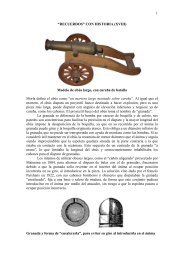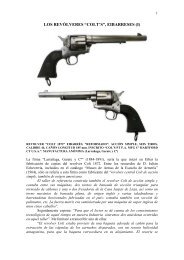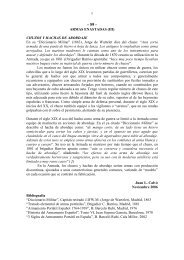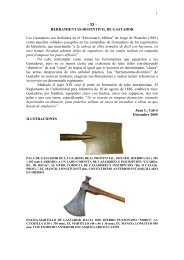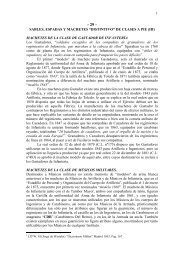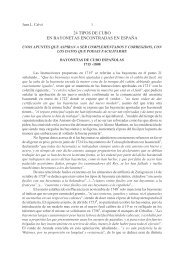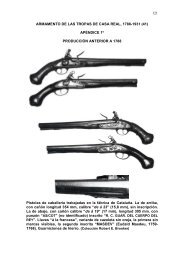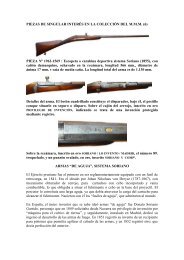22 armaments of the troops of the royal household, 1788-1931
22 armaments of the troops of the royal household, 1788-1931
22 armaments of the troops of the royal household, 1788-1931
Create successful ePaper yourself
Turn your PDF publications into a flip-book with our unique Google optimized e-Paper software.
ARMAMENTS OF THE TROOPS OF THE ROYAL HOUSEHOLD, <strong>1788</strong>-<strong>1931</strong><br />
(7)<br />
EQUIPMENT OF THE BRIGADE OF “ARTILLERÍA VOLANTE”<br />
ATTACHED TO THE ROYAL CORPS OF “GUARDIAS DE CORPS”,<br />
1797-1803<br />
(Translation by Héctor J. Meruelo)<br />
Mounted Artillery musketoon; 675 mm long ,18 mm (“de a 17”) caliber<br />
barrel, dated 1803 , marked under Crown “GA/BIO/LA” (Andres de<br />
Gabiola, Eibar) provided with lug for attachment <strong>of</strong> a socket bayonet,<br />
probably a sword-bayonet; Spanish lock, Biscayne variant, marked<br />
“BOLVN”(unidentified); Oval brass insert inscribed “R” under Crown<br />
embedded in its stock; Total overall length <strong>of</strong> <strong>the</strong> weapon 1,020 mm.<br />
The “Artilleria Volante” (literally “Flying Artillery”), a mounted Artillery force<br />
designed to support <strong>the</strong> Cavalry, was conceived by <strong>the</strong> artilleryman, Don<br />
Vicente Maria de Maturana, using eight pounder cannon <strong>of</strong> <strong>the</strong> same length as<br />
four pounders, although weighing seventy more pounds, which could fire ei<strong>the</strong>r<br />
shot or grenades; Called “Maturana’s maneuver cannon” or “lightened cannon”,<br />
<strong>the</strong>y were a precedent to <strong>the</strong> future “obuses largos” (howitzers); They suffered<br />
from one defect in that, as <strong>the</strong> exact position <strong>of</strong> <strong>the</strong> (round) grenade inside <strong>the</strong><br />
bore was not known, sometimes its fuse could contact <strong>the</strong> charge and explode<br />
inside <strong>the</strong> piece; In 18<strong>22</strong> a French artilleryman, Henry Joseph Paixhans<br />
designed a sabot system to prevent this accident from happening.<br />
<strong>22</strong>
After being tested in Buenos Aires, <strong>the</strong>y were demonstrated to Carlos IV in<br />
Aranjuez, in 1795, and in 1797 he ordered <strong>the</strong> creation <strong>of</strong> a Brigade <strong>of</strong> ”Artillería<br />
Volante” to be attached to <strong>the</strong> Royal Corp <strong>of</strong> “Guardias de Corps”, with eight<br />
pieces and a staff composed <strong>of</strong> one “Comandante” (<strong>the</strong> above mentioned<br />
Colonel Maturana), one Captain, three Lieutenants, two Sergeants, one<br />
Drummer or Bugler, four Corporals and fifty three artillerymen.<br />
In 1801, due to <strong>the</strong> war with Portugal, its numbers were increased and<br />
formed into two Divisions; Forming <strong>the</strong>ir Main Staff were: One “Comandante”<br />
(Maturana, now a Brigadier), two Aids, one Brigade Sergeant, two Buglers, and<br />
one “Mayoral” (a foreman in charge <strong>of</strong> <strong>the</strong> horses), and, in each Division, one<br />
Captain, two Lieutenants, two Sergeants, four Corporals, eight “Artilleros-<br />
Postillones”, and thirty- eight “Artilleros Volantes” in <strong>the</strong> First Division, and thirtyseven<br />
in <strong>the</strong> Second one; They each had four four-pounders and four eightpounder<br />
“licornes” (lightened pieces).<br />
It was formed with Officers and troopers drawn from <strong>the</strong> Royal Artillery<br />
Corp, but it was disbanded in April <strong>of</strong> 1803; Those existing illustrations <strong>of</strong> <strong>the</strong>ir<br />
gunners show <strong>the</strong>m equipped only with machetes, which must have been very<br />
similar, if not identical to, <strong>the</strong> one adopted in 1802 for <strong>the</strong> Army gunners.<br />
Artillery machete, Model <strong>of</strong> 1802; Slightly curved, fullered, single edged,<br />
520 x 46 mm blade, flat spine up to <strong>the</strong> double edged clip-point; Brass<br />
handle, lea<strong>the</strong>r scabbard with brass mounts including two channels for<br />
<strong>the</strong> needles used to clean <strong>the</strong> flashpans.<br />
As a mounted force we can assume that <strong>the</strong>y had numbers armed with<br />
musketoons or “tercerolas” (cavalry musketoons) perhaps <strong>of</strong> <strong>the</strong> same model as<br />
<strong>the</strong> one shown at <strong>the</strong> start <strong>of</strong> this article where <strong>the</strong> Crowned marking on its<br />
barrel tells us that it was special equipment, contracted by a specific unit ,<br />
to <strong>the</strong> Placencia Gunmakers Guilds for its exclusive use, in contrast to <strong>the</strong><br />
regular issue weapons made in <strong>the</strong> Placencia Royal Factory for <strong>the</strong> regular<br />
Army <strong>troops</strong>.<br />
The carbine, specimen number 1973 in <strong>the</strong> collection <strong>of</strong> <strong>the</strong> “Museo de<br />
Artillería”, is one <strong>of</strong> <strong>the</strong>se regular issue weapons, and is identified in both <strong>the</strong><br />
Catalogues <strong>of</strong> 1856 and 1911 as <strong>the</strong> model that equipped <strong>the</strong> Horse Artillery<br />
Brigades created in <strong>the</strong> Regulations <strong>of</strong> 1802, which organized <strong>the</strong> Corp into five<br />
Regiments <strong>of</strong> twelve companies, forming three Brigades, two Divisional<br />
brigades and one Headquarters Brigade, and one <strong>of</strong> <strong>the</strong> Divisional Brigades in<br />
each <strong>of</strong> <strong>the</strong> first four Regiments was a mounted Brigade; In <strong>the</strong> fifth regiment,<br />
<strong>the</strong> two Divisional brigades were on foot, as also were <strong>the</strong> Headquarters<br />
brigades .<br />
23
Standard issue carbine, number 1973 <strong>of</strong> <strong>the</strong> collection <strong>of</strong> <strong>the</strong> “Museo del<br />
Ejército”, catalogued as “Model 1802” for horse artillery; 18 mm caliber<br />
(“de a 17”), 847 mm long barrel, with mounting lug for a machete-bayonet;<br />
Spanish lock, Biscayne variant; Specimen marked “2º Rº , 3ª Bª , 3ª Cª Nº.<br />
24” (2 nd regiment, 3 rd brigade, 3 rd company, number 24); Overall length<br />
1190 mm .<br />
Better suited to <strong>the</strong> equipment <strong>of</strong> mounted artillery is <strong>the</strong> following specimen <strong>of</strong><br />
musketoon, made in <strong>the</strong> Valencia Factory, which was created in November <strong>of</strong><br />
1808 and was active until early 1812 when <strong>the</strong> French occupied <strong>the</strong> city and<br />
disassembled it.<br />
Standard issue musketoon for mounted artillery; 660 mm long, 18mm<br />
caliber (“de a 17”), with mounting lug for a machete-bayonet ; Spanish<br />
lock , Biscayne variant , marked “FA.VA.” (Fábrica de Valencia); Overall<br />
length 1037 mm; Missing <strong>the</strong> rear sling ring.<br />
The first specimen shown in this article, lacking any sling rings, can be defined<br />
as an irregular “tercerola”, as its barrel has a bayonet lug , while this last shown<br />
specimen , also with bayonet lug, but with sling rings, is a conventional model <strong>of</strong><br />
musketoon for mounted artillery.<br />
Juan L. Calvó,<br />
October, 2011.<br />
Bibliography :<br />
M. Gómez Ruiz and V. Alonso Juanola, “El Ejercito de los Borbones”, Vol.IV,<br />
Madrid, 1995.<br />
Catalogues <strong>of</strong> <strong>the</strong> “Museo de Artillería”, Madrid, 1856 and 1911, Vol. II.<br />
Manuel Giménez González, “El Ejercito y la Armada, desde la antigüedad<br />
hasta1862”, Madrid, 2003.<br />
Juan L. Calvó, “Armamento Español en la Guerra de la Independencia”, Madrid,<br />
2008.<br />
24
NOTE<br />
These works are copyrighted and are <strong>the</strong> intellectual property <strong>of</strong> <strong>the</strong> author.<br />
Reproduction by any means without <strong>the</strong> author’s previous explicit authorization is<br />
forbidden and penalized by law.<br />
However, it may be downloaded for personal use,<br />
as a service to <strong>the</strong> collecting community.<br />
25



